At the intersection of hiking and composing
By Christina Rusnak, November 11 2015
“Sound is one of the original, magical elements of the Earth’s ecosystem … Giving [music] breath and beauty is what we call music making.” – Composer John Kennedy
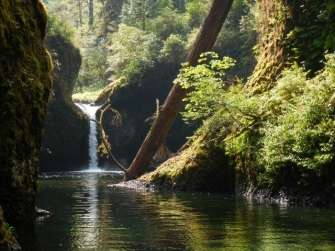 Like us, sound and music require air. Our forests and natural areas, and all they encompass, breathe.
Like us, sound and music require air. Our forests and natural areas, and all they encompass, breathe.
Composers create music to reflect our human experience. Research is mounting that getting outside and experiencing nature is essential for our health. The Japanese have a name for it: shinrin-yoku - breathe, relax, wander, touch, listen, heal.
I myself am a product of the transformative power of natural landscapes. A field botany class in college, requiring hiking over 60 miles in Big Bend National Park in West Texas, literally changed my life. Hiking transforms me into my best self! I’ve been composing music since I was nine years old, but didn’t pursue it professionally until my 30s. While in grad school, a visiting composer presented a musical work about that same park, and that day I made the decision to integrate my two great passions – hiking and composing. (At 12, I wrote a song called A Piece of Wilderness. Today it seems prescient.)
After years of visiting, I moved to Portland in 2012 ready to discover my new world. A friend recommended The Intertwine Alliance as an aid to my explorations. I typed in my search and found 166 trails! “The Intertwine isn’t just our region’s network of parks, trails, and natural areas. It’s a redefinition of where we live,” says The Alliance’s website. My sense is that it is also a redefinition of how we live – a way of seeing and being in the world. Most recently, I rambled along the Canemah Bluff discovering the landscape of the southern end of Oregon City.
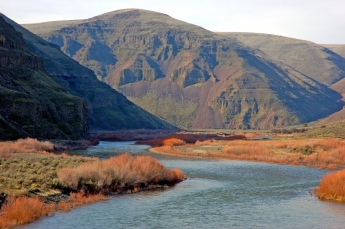 By nature, I’m an explorer. This informs all of my endeavors – including composing. Curious to understand how people and place intersect, I work to integrate those ideas and questions into musical form by immersing myself in the landscape, experiencing as much of its diversity as possible. So how do I begin?
By nature, I’m an explorer. This informs all of my endeavors – including composing. Curious to understand how people and place intersect, I work to integrate those ideas and questions into musical form by immersing myself in the landscape, experiencing as much of its diversity as possible. So how do I begin?
It starts with a hike, and a strong connection to the natural world that I’m writing about. Largely, I’m not trying to replicate the sounds of nature, but seeking to interpret my outdoor experiences and express them through sound.
The nature of experiencing landscape is transitory. The environment shifts and transforms before our eyes and under our feet. Weather changes quickly and dynamically impacts all it touches. We perceive our world differently in scorching sun, filtered fog or in a cold howling wind. Are the flowers glistening from a morning rain, or are the grasses dry and brown from a month without? For centuries, people have orchestrated their lives by the chaotic and transitory nature of the sea, the landscape and its arteries. Are the whales migrating, the salmon swimming up stream, the bees pollinating? Are the grasses swaying, is the wind blowing nuts off the trees? All of these have sound. All of these have color.
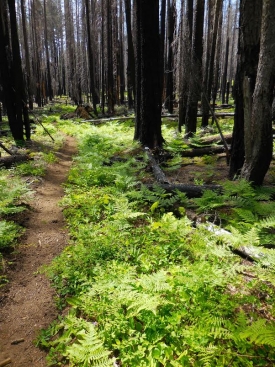 I research the physical geography, geology, flora and fauna. I ask myself questions: What senses are engaged? What is my point of view? Am I composing strictly about the visible aspects of the landscape or something more?
I research the physical geography, geology, flora and fauna. I ask myself questions: What senses are engaged? What is my point of view? Am I composing strictly about the visible aspects of the landscape or something more?
In the relatively small region of The Intertwine, the landscape comprises a vast amount of diversity. Thus, the individual landscape morphs the approach and process I take in composing about one place or another. Many of our most scenic places overlap with a rich human history, so I also explore the cultural geography of the landscape over time.
At this point, the aspect of the landscape I want to focus on emerges. The impetus for The Life of Ashes was the 2012 fire that ravaged the Mount Adams Wilderness. Specifically, I wanted to show how that event connected to the language of the 1964 Wilderness Act and the ever-changing and temporal characteristic of the landscape, where the natural process of nature - life, death and rebirth - march on with minimal interference. A wilderness, reads the act, "is hereby recognized as an area where the earth and its community of life are untrammeled by man, where man himself is a visitor who does not remain.” I composed the piece from the point of view of the mountain – not the sound of the fire, but its intrinsic feeling of anguish and of hope.
You can listen to and watch a performance of The Life of Ashes -- with The Intertwine Alliance's own Janet Bebb on flute! -- in this YouTube video.
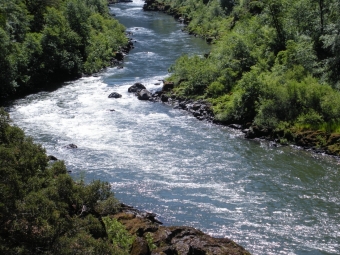 Hiking for several days through a natural area or park, I could write the music from beginning to end. Going Rogue in the Rogue River Wilderness is an example of this kind of piece. The problem is that my hike may not be fully representative of the place. Often the process involves mapping out the piece. Even if I don’t adhere to it, I find that creating a plan for the composition fleshes out both the musical and the non-musical ideas, as well as provides a general shape and time frame for the music.
Hiking for several days through a natural area or park, I could write the music from beginning to end. Going Rogue in the Rogue River Wilderness is an example of this kind of piece. The problem is that my hike may not be fully representative of the place. Often the process involves mapping out the piece. Even if I don’t adhere to it, I find that creating a plan for the composition fleshes out both the musical and the non-musical ideas, as well as provides a general shape and time frame for the music.
What instruments should I choose? I consider what makes sense for the landscape itself, the sound world I want to create, and what’s practical for the place(s) in which the music will be performed. For The Life of Ashes I chose flute, viola and percussion - primarily marimba and bass drum. A significant portion of the Mount Adams Wilderness lies within the Yakima Reservation, so the flute and drum are ancient and integral instruments of the landscape. The wood of the marimba and viola represent its mountain forest.
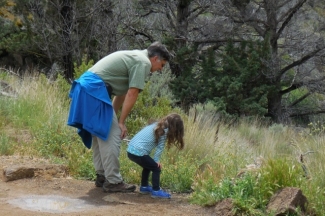 “Music is a medium inextricably linked with time, on many levels,” writes composer Nell Shaw Cohen, in a blog post about her piece Point Reyes From Chimney Rock. We concurrently experience music in the present time, its complex divisions of time, and its change over time. Likewise, our ecological world concurrently embodies the past, present and future – ancient geology, old-growth forest, flowing waters, ripening berries and a home for future generations of wildlife. The Life of Ashes contains three distinct sections; during the last minute of the piece, I added a new theme to communicate the old adage that one can never step in the same river twice. After a fire, the forest regenerates, but in new ways – it never re-grows exactly the same as before.
“Music is a medium inextricably linked with time, on many levels,” writes composer Nell Shaw Cohen, in a blog post about her piece Point Reyes From Chimney Rock. We concurrently experience music in the present time, its complex divisions of time, and its change over time. Likewise, our ecological world concurrently embodies the past, present and future – ancient geology, old-growth forest, flowing waters, ripening berries and a home for future generations of wildlife. The Life of Ashes contains three distinct sections; during the last minute of the piece, I added a new theme to communicate the old adage that one can never step in the same river twice. After a fire, the forest regenerates, but in new ways – it never re-grows exactly the same as before.
Our diverse landscapes call for a variety of musical approaches. In Going Rogue, I use short bursts of notes, uneven rhythms and rising pitches, each instrument punctuated by the interruption of the other instruments to try to convey the churning rocky rapids between which the water calmly flows.
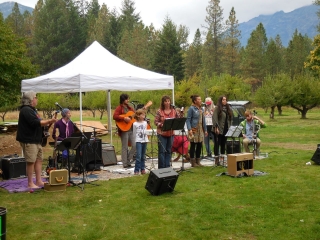 Landscape music can advocate for the very places we are composing for. How? Music about place can be performed anywhere! In other words, our musical expression “can be a conduit for communicating, understanding and encapsulating human experiences of the natural world," writes Cohen, as part of the explanation of why she started landscapemusic.org. We are able to be some of our landscapes’ best advocates, because we take the time to experience its essence and translate it into sound: pitch, rhythm, gesture, color, dynamics, attack and decay.
Landscape music can advocate for the very places we are composing for. How? Music about place can be performed anywhere! In other words, our musical expression “can be a conduit for communicating, understanding and encapsulating human experiences of the natural world," writes Cohen, as part of the explanation of why she started landscapemusic.org. We are able to be some of our landscapes’ best advocates, because we take the time to experience its essence and translate it into sound: pitch, rhythm, gesture, color, dynamics, attack and decay.
I believe music – all creative expression, actually – is critical to our well-being, our individual and collective vibrancy, and to connecting with one another and ourselves. Likewise access, participation and interaction with The Intertwine’s “shared landscape of two mountain ranges, five watersheds, innumerable species of plants, trees, and wildlife, and 37 annual inches of cool, clean rain” is vital to the health of our communities, our well-being and to connect us with our past, present and future.
Interested in seeing Christina perform live? The premiere of The Way Through, which she wrote for North Cascades National Park, will be performed at “Crazy Jane Prevails” this Friday, Nov. 13, at 7:30 p.m. at Portland State University.

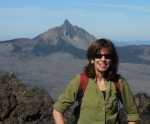 Christina Rusnak is an active composer who seeks to integrate, landscape, geography and artistic expression into her work. An avid hiker, Christina composed Canyon Voices in 2013, commissioned by Oregon State Parks, and The Life of Ashes to commemorate the 50th anniversary of the Wilderness Act in 2014. She also works with communities and organizations to bring music, culture and heritage into public spaces:
Christina Rusnak is an active composer who seeks to integrate, landscape, geography and artistic expression into her work. An avid hiker, Christina composed Canyon Voices in 2013, commissioned by Oregon State Parks, and The Life of Ashes to commemorate the 50th anniversary of the Wilderness Act in 2014. She also works with communities and organizations to bring music, culture and heritage into public spaces:
Add new comment